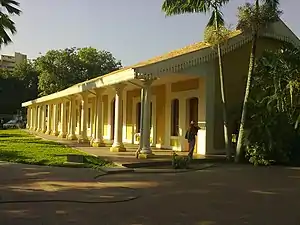Camoruco railway station
The Camoruco railway terminus (Spanish: Estación Camoruco del Ferrocarril) in Valencia, Venezuela, is a rare survival of a 19th century railway station in the South America country. The building is also known as the Rectorado of the University of Carabobo. When the Puerto Cabello and Valencia railway closed in the 1950s, the station was transferred to the University of Carabobo which converted it for administrative use.[1]
Camoruco station Antigua Estación Camoruco del Ferrocarril | |
|---|---|
| Former terminus of the Puerto Cabello and Valencia railway | |
 The former station is now part of the University of Carabobo | |
| General information | |
| Location | Valencia, Venezuela |
| Owned by | (currently) University of Carabobo |
| Construction | |
| Structure type | Limited use of cast iron |
| History | |
| Opened | 1888 |
| Closed | 1959 |
Location
Camoruco is a suburb of Valencia 3 km from the city centre. While the railway line was in operation, there was a tram service from the station to the Plaza Bolivar in the centre. Initially the trams were horse-drawn, but were powered by electricity from some point in the 20th century.[2]
Architecture
The building respects Spanish Colonial tradition, although the structure was advanced for its time in making use of cast iron imported from England,[3] Traditional materials were also used.
 Colonial architecture, as in this courtyard at Coro, presents a parallel with the railway station
Colonial architecture, as in this courtyard at Coro, presents a parallel with the railway station The Casa del Congreso de Angostura, an 18th century building in Ciudad Bolívar
The Casa del Congreso de Angostura, an 18th century building in Ciudad Bolívar
History
Guzman Blanco, the president of Venezuela, gave a concession to a British company to build a railway between Valencia and the Caribbean coast at Puerto Cabello. The 55 km route of the Puerto Cabello and Valencia railway crossed a range of mountains.[4] The railway was inaugurated in 1888. The railway was known locally as the English railway, distinguishing it from the Great Venezuela Railway, a slightly later German-built line.[note 1] However, the Puerto Cabello Valencia line was not the only British-built railway in the country, and the La Guaira and Caracas Railway was also known as the English railway.
The right to construct and to operate the railway was to be an exclusive one for ninety-nine years from the date of its completion. However, rail transport in Venezuela became neglected. It went into a major decline from the 1950s, with road transport taking its place.
Revival of rail
In the 21st century a metro system opened in Valencia as a north-south route passing near the old terminus. One of the stations is called Francisco de Miranda (Rectorado).[5] The metro system is planned to connect to a new railway line to the coast at an interchange in Naguanagua Municipality.
Notes
- Both lines used the same gauge and they were eventually connected at Valencia.
References
- Delgado, Y; Manama, L (2007). "Ferrocarril Venezolano: Mirando el pasado y presente" [Venezuelan railway] (PDF) (in Spanish). Archived from the original (PDF) on 14 April 2019. Retrieved 2019-04-14.
- Morrison, A. "Map of Valencia". Retrieved 14 April 2019.
- Silva, M. "Foreign Iron in Venezuelan Architecture" (PDF). Retrieved 14 April 2019.
- . Encyclopædia Britannica. Vol. 27 (11th ed.). 1911.
- Laguna (2018). "Enfermeras de Carabobo protestan en estación del Rectorado del Metro" [Carabobo nurses protest at the Rectorate Metro station] (in Spanish). Archived from the original on 20 July 2018.